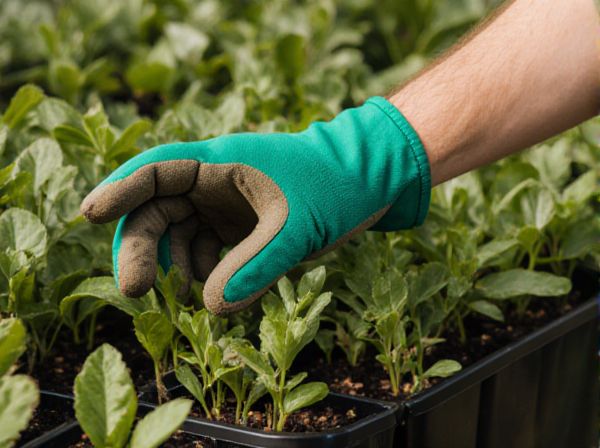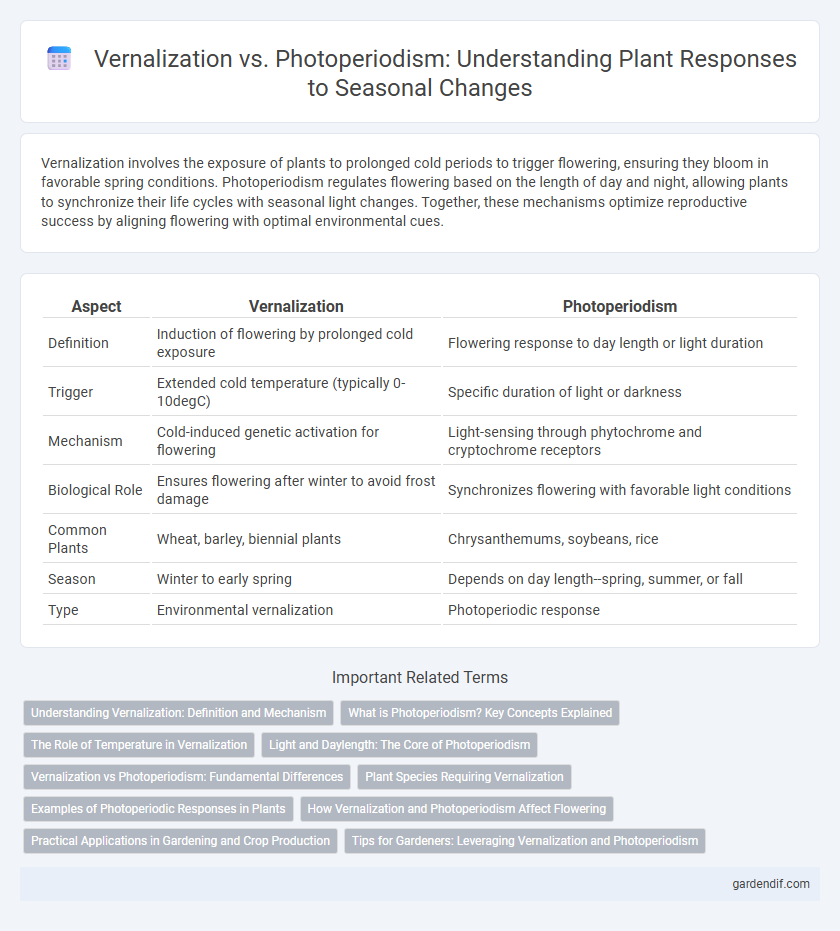
Vernalization vs Photoperiodism Illustration
Vernalization involves the exposure of plants to prolonged cold periods to trigger flowering, ensuring they bloom in favorable spring conditions. Photoperiodism regulates flowering based on the length of day and night, allowing plants to synchronize their life cycles with seasonal light changes. Together, these mechanisms optimize reproductive success by aligning flowering with optimal environmental cues.
Table of Comparison
| Aspect | Vernalization | Photoperiodism |
|---|---|---|
| Definition | Induction of flowering by prolonged cold exposure | Flowering response to day length or light duration |
| Trigger | Extended cold temperature (typically 0-10degC) | Specific duration of light or darkness |
| Mechanism | Cold-induced genetic activation for flowering | Light-sensing through phytochrome and cryptochrome receptors |
| Biological Role | Ensures flowering after winter to avoid frost damage | Synchronizes flowering with favorable light conditions |
| Common Plants | Wheat, barley, biennial plants | Chrysanthemums, soybeans, rice |
| Season | Winter to early spring | Depends on day length--spring, summer, or fall |
| Type | Environmental vernalization | Photoperiodic response |
Understanding Vernalization: Definition and Mechanism
Vernalization is a physiological process in plants where prolonged exposure to low temperatures accelerates flowering, ensuring reproductive success in spring. This cold-induced mechanism involves the epigenetic regulation of flowering genes, such as the repression of flowering locus C (FLC), allowing plants to transition from vegetative to reproductive stages. Understanding vernalization is crucial for crop breeding and adaptation, particularly in temperate climates where seasonal cues dictate growth cycles.
What is Photoperiodism? Key Concepts Explained
Photoperiodism is the physiological reaction of plants to the length of day or night, crucial for regulating flowering and other developmental processes. It enables plants to synchronize their growth cycles with seasonal changes by detecting light duration through specialized photoreceptors. Understanding photoperiodism helps optimize agricultural practices by predicting flowering times and improving crop yields in different climatic zones.
The Role of Temperature in Vernalization
Vernalization involves the exposure of plants to prolonged cold temperatures to trigger flowering, ensuring they bloom at the appropriate season. Temperature acts as a crucial environmental signal, enabling the accumulation of molecular changes that break plant dormancy and promote reproductive development. This cold-induced process contrasts with photoperiodism, which relies on day length rather than temperature to regulate flowering time.
Light and Daylength: The Core of Photoperiodism
Photoperiodism centers on the plant's ability to detect changes in light and daylength, which directly influence flowering and growth cycles. Unlike vernalization, which requires prolonged cold exposure to trigger flowering, photoperiodism relies on the duration and quality of light, specifically the ratio of day to night. This light-dependent mechanism involves phytochrome pigments that measure night length, enabling plants to adapt their development to seasonal changes.
Vernalization vs Photoperiodism: Fundamental Differences
Vernalization involves the induction of a plant's flowering process through exposure to prolonged cold temperatures, while photoperiodism depends on the length of day and night to trigger flowering. Vernalization ensures flowering occurs after winter, preventing premature blooming, whereas photoperiodism adjusts flowering times according to seasonal light changes. These mechanisms differ fundamentally in their environmental cues--temperature for vernalization and light duration for photoperiodism--playing crucial roles in plant adaptation and reproductive success.
Plant Species Requiring Vernalization
Plant species requiring vernalization, such as winter wheat, sugar beet, and biennial carrots, depend on prolonged exposure to cold temperatures to initiate flowering. This cold treatment triggers physiological changes that enable these plants to transition from the vegetative to the reproductive stage. Vernalization ensures that flowering occurs only after winter, optimizing reproductive success and aligning growth cycles with favorable spring conditions.
Examples of Photoperiodic Responses in Plants
Photoperiodism in plants regulates critical developmental processes such as flowering, tuber formation, and dormancy based on day length. Long-day plants like spinach and clover flower when exposed to extended daylight, while short-day plants such as chrysanthemum and soybean initiate flowering during shorter days. Day-neutral plants, including tomatoes and cucumbers, do not rely on photoperiod cues for development, highlighting diverse adaptive strategies in response to seasonal changes.
How Vernalization and Photoperiodism Affect Flowering
Vernalization accelerates flowering by exposing plants to prolonged cold, triggering the expression of flowering genes essential for seasonal development. Photoperiodism regulates flowering based on day length, with long-day and short-day plants initiating blooms when specific light durations are met. Together, these processes synchronize flowering to optimal environmental conditions, ensuring reproductive success.
Practical Applications in Gardening and Crop Production
Vernalization involves exposing plants like wheat and spinach to prolonged cold to induce flowering, enhancing crop yield and uniformity in temperate climates. Photoperiodism regulates flowering in species such as soybeans and chrysanthemums by manipulating day-length, allowing growers to optimize planting schedules and extend growing seasons. Combining vernalization and photoperiod control enables precise management of flowering times, improving productivity and quality in horticulture and agricultural systems.
Tips for Gardeners: Leveraging Vernalization and Photoperiodism
Gardeners can optimize plant growth by understanding that vernalization requires a period of cold exposure to trigger flowering in certain species like winter wheat and tulips, while photoperiodism depends on day length changes to regulate flowering in crops such as soybeans and chrysanthemums. Ensuring seeds or bulbs undergo appropriate chilling periods before planting enhances vernalization effects, whereas manipulating light duration with artificial lighting can control photoperiodic responses for off-season flowering. Monitoring temperature and light cycles helps synchronize plant development with seasonal conditions, improving yield and ornamental quality.
Vernalization vs Photoperiodism Infographic

 gardendif.com
gardendif.com